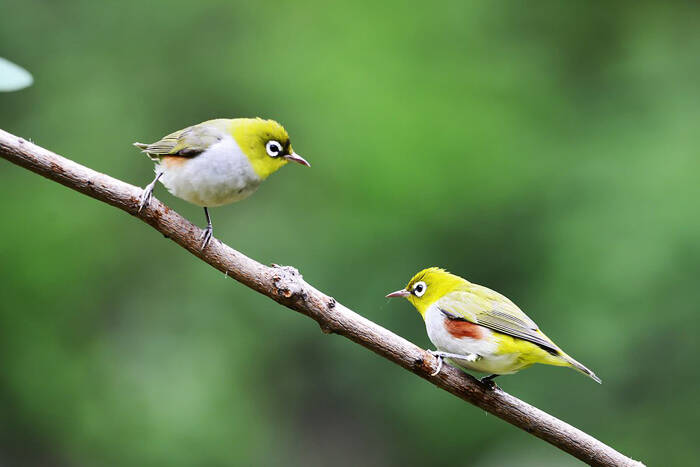Zosterops erythropleurus
IUCN
LCBasic Information
Scientific classification
- name:Zosterops erythropleurus
- Scientific Name:Zosterops erythropleurus,Chestnut-flanked White-eye,White eyes, pink eyes, brown eyes, red eyes with white eyes, red eyes with pink eyes
- Outline:Songbird
- Family:passerines white-eye genus
Vital signs
- length:10-12cm
- Weight:12-13g
- lifetime:6-12years
Feature
The upper body is mostly gray, with chestnut on the flanks (sometimes not visible)
Distribution and Habitat
Origin: Cambodia, China, North Korea, Lao People's Democratic Republic, South Korea, Myanmar, Russian Federation, Thailand, Vietnam.
Origin uncertain: Japan.
It breeds in Northeast China and winters south to Central, South and East China. It is common in primary forests and secondary forests above 1,000 meters above sea level.
In China, it is distributed in Heilongjiang, Jilin, Hebei, Liaoning, Shanxi, Shaanxi, Gansu, Sichuan, Tibet, Henan, Shandong, Jiangsu, Zhejiang, Fujian, Guizhou, Yunnan and other places.
It lives in various types of forests such as broad-leaved forests and mixed coniferous and broad-leaved forests dominated by broad-leaved trees, bamboo forests, and secondary forests. It also lives in orchards, forest edges, and tall trees in villages and land. It is migratory. In summer, it mostly migrates to the north and high-altitude cool areas, sometimes reaching coniferous forests at an altitude of about 2,000 meters. In winter, it mostly migrates to the so
Appearance
Adult male Red-flanked White-eye (spring plumage): The upper body from the forehead base, back to the upper tail coverts are yellow-green, with less yellow on the upper back and dark green; the cheeks and ear feathers are yellow-green; there is a circle of velvety white short feathers around the eyes; the front of the eyes is black; there is a fine black line under the eyes; the shoulders and small coverts are dark green, the flight feathers and the remaining coverts are dark brown, except for the small wing feathers and the first (very small) and second primary flight feathers, the outer feathers of the remaining feathers are all edged with dark green; the tail feathers are dark brown, and the outer feathers of each feather are all edged with yellow-green; the chin, throat, neck and forechest are bright sulfur yellow; the center of the back chest and abdomen is milky white, and the sides of the back chest are pale gray; the flanks are chestnut red; the undertail coverts are bright sul
Details
Chestnut-flanked White-eye, no subspecies.

Chestnut-flanked White-eye often moves alone, in pairs or in small groups. They like to move in groups during the migration season and winter, sometimes with up to 50-60 birds. It shuttles and jumps between branches and flowers in secondary forests and shrubs, or flies from one tree to another. Sometimes it circles around branches or suspends on flowers by rapidly vibrating its wings, making a faint "hissing" sound when it moves.
The breeding season of red-flanked white-eye is from April to July, and some start nesting as early as March. Nests are built on broad-leaved or coniferous trees and shrubs. The nests are in the shape of hanging baskets or cups, mainly composed of grass stems, grass leaves, mosses, bark, spider silk, kapok fluff, etc., and are padded with palm silk, feathers, fine roots, grass stems, wool, etc. The nests are mostly suspended on the ends of thin side branches or branches, surrounded by dense branches and leaves, and are not easy to find. The height is 1-10 meters from the ground. The outer diameter of the nest is 6.0-7.5 cm, the inner diameter is 4-5.8 cm, the height is 4-6 cm, and the depth is 2.7-4.6 cm. Reproduce 1-2 nests per year. Each nest lays 3-4 eggs, mostly 3. The eggs are light blue-green or white.
Listed in the "Red List of Endangered Species of the World Conservation Union" (IUCN) 2016 ver 3.1-Least Concern (LC).
Listed in the "National List of Terrestrial Wildlife with Important Economic and Scientific Research Value" (Item 631) issued by the State Forestry Administration on August 1, 2000.
Listed in the second level of China's "National Key Protected Wildlife List" (February 5, 2021).
Protect wild animals and stop eating game.
Maintaining ecological balance is everyone's responsibility!








